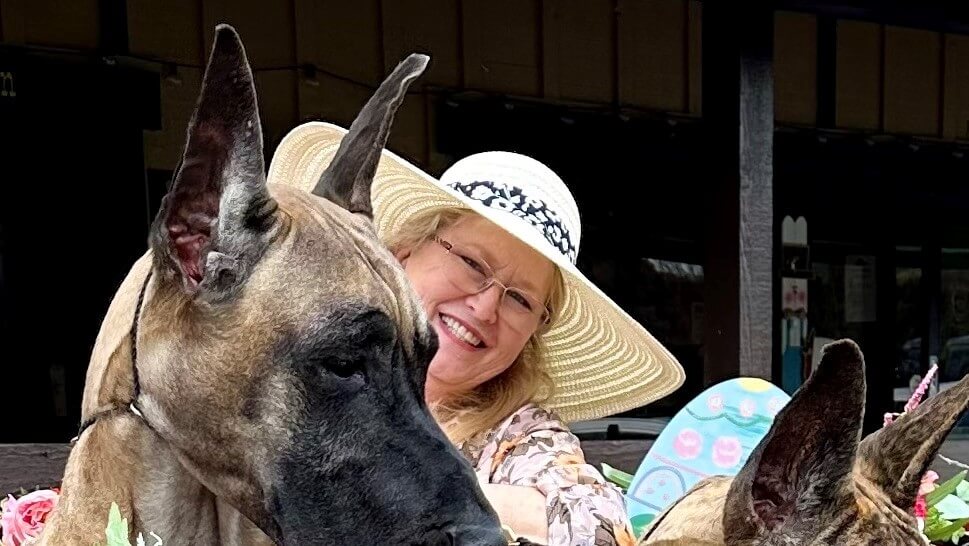
Home » Paula Johnson, DVM, MS, CPIA | Rocky Creek Danes

Paula Johnson, DVM, MS, CPIA
1. I have lived in Tucson, Arizona, since our family moved here in 1970. Our first Great Dane, a brindle named Abigail, came to our family in 1971 from the champion lines of the Lindamood’s and Hopp’s, both of Southern Arizona. My first litter was born in 1976, and since that first experience there have been six litters, three of which were co-bred litters. My kennel name is Rocky Creek Danes, but most recently I’ve been co-breeding with Mari Lynn Davisson, Melissa Meyer, and Joan Apuna. Our combined kennel name is “ShalaRockOlyPac” and it has been a great collaboration.
2. Our process for selecting show puppies has been to wait at least five weeks or older to evaluate, based on head, topline, angles, and personality. This has been, and always will be, done with the input and guidance of fellow Dane enthusiasts—they know who they are! No matter what criteria we use to make selections or how promising a puppy may look, it will always be a “wait and see” situation as they grow. There is so much change as a puppy grows that all we can do is make a best guess.
I haven’t placed many puppies that were selected specifically for performance puppies, but I would have to say temperament and drive would be the most obvious traits I select for, beyond being a good, sound, well-rounded puppy.
3. I feel the breeders are trying to breed for sound bodies, smooth movement, and good temperament, so yes, overall all I think the breed is in good condition. That being said, there is always room for improvement, which is why we try to strive to advance each generation.
A trend that raises concern, and is being seen more frequently, is dogs are getting taller in leg, i.e., more leg than chest. Tall and big are fine, but the Breed Standard states, “The elbow should be one-half the distance from the withers to the ground.” When the leg is too long (too tall from the elbow to the ground), it gives the appearance of a shallow chest. The chest “shall be broad, deep and well muscled” and the “brisket extends to the elbow.” As breeders, we must remember that, as a Working breed, we must strive to preserve the strength and elegance that are combined with the great size and power, which is the breed type that creates a Dane’s regal appearance.
4. With the loss of many respected judges, the sport has lost a wealth of knowledge. It seems many of the newer judges have not spent enough time being mentored by knowledgeable Great Dane breeder-judges who could adequately train them to the Great Dane Standard.
It would always be helpful to have more opportunities to show, but with the economic situation it is becoming more financially difficult. It is disappointing that some of the shows are being cancelled due to the cost of venues.
5. In my opinion, social media has the potential to expose more people to the fun of the sport and bring in more participants. The downside of social media seems to be that some people have the feeling they can say anything about (or to) anyone, regardless of the negativity and the poor sportsmanship it demonstrates. There is so much negativity that is aired, and I feel this is what people who are not around the dog show world will take away.
6. I feel the biggest challenge we all face is being kind to one another at all times, remembering that good sportsmanship should always be visible if we are to recruit new people to the sport we claim to love.
7. Some of the positive changes I’ve seen have been the increase in visibility of showcasing Junior and Pee-Wee Handlers. The sooner we can get them hooked, the better! We need fresh, young perspectives in this sport, and encouraging them at every opportunity will allow this sport to continue.